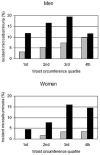Central obesity, incident microalbuminuria, and change in creatinine clearance in the epidemiology of diabetes interventions and complications study
- PMID: 17151331
- PMCID: PMC2622719
- DOI: 10.1681/ASN.2006040394
Central obesity, incident microalbuminuria, and change in creatinine clearance in the epidemiology of diabetes interventions and complications study
Abstract
Weight gain and central obesity are associated with insulin resistance, hypertension, and dyslipidemia in type 1 diabetes. These metabolic abnormalities are risk factors for kidney disease in the general population, but data addressing the relationship of central obesity with kidney disease in type 1 diabetes are limited. Whether waist circumference is associated with incident microalbuminuria and change in creatinine clearance was examined among 1279 participants who had type 1 diabetes and were enrolled in the Epidemiology of Diabetes Interventions and Complications Study, the observational extension of the Diabetes Control and Complications Trial (DCCT). Ninety-three of 1105 participants with normal albumin excretion rate (AER) at DCCT closeout developed incident microalbuminuria over 5.8 yr of follow-up. The hazard ratio for incident microalbuminuria that was associated with each 10-cm greater waist circumference at DCCT closeout was 1.34 (95% confidence interval 1.07 to 1.68), after adjustment for DCCT closeout age, gender, duration of diabetes, treatment group, smoking status, glycosylated hemoglobin, and AER. This increased risk was modestly attenuated when additional adjustment was made for levels of BP and serum lipids. Creatinine clearance declined by an average of 0.34 ml/min per 1.73 m2 each yr over 8 yr of follow-up. Greater rate of decline in creatinine clearance was associated with greater age, conventional insulin therapy during the DCCT, smoking, and greater glycosylated hemoglobin and AER at DCCT closeout but not with waist circumference. In conclusion, waist circumference predicts the subsequent development of microalbuminuria in type 1 diabetes. In contrast, no association of waist circumference with decline in creatinine clearance was observed.
Figures

 , intensive insulin therapy.
, intensive insulin therapy.
References
-
- US Renal Data System . USRDS 2004 Annual Data Report: Atlas of End-Stage Renal Disease in the United States. National Institutes of Health, National Institute of Diabetes and Digestive and Kidney Diseases; Bethesda: 2004.
-
- Effect of intensive therapy on the development and progression of diabetic nephropathy in the Diabetes Control and Complications Trial. The Diabetes Control and Complications (DCCT) Research Group. Kidney Int. 1995;47:1703–1720. - PubMed
Publication types
MeSH terms
Substances
Grants and funding
LinkOut - more resources
Full Text Sources
Medical

